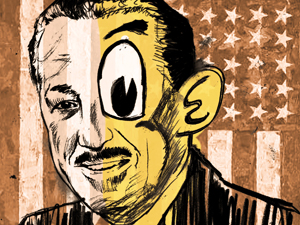
Man in the Middle: On Philip Glass Man in the Middle: On Philip Glass
Philip Glass’s new opera, The Perfect American, is a mix of bluster and inspiration.
Mar 27, 2013 / Books & the Arts / Jonathan Blitzer
30 Seconds Over Toledo: How Political Ads Spell Trouble for TV News and Democracy 30 Seconds Over Toledo: How Political Ads Spell Trouble for TV News and Democracy
In the wake of Citizens United, big campaign donors are buying off not only politicians, but also the local news networks that cover them.
Mar 21, 2013 / Blog / Eric Alterman and Reed Richardson

On the Politics of ‘Scandal’ On the Politics of ‘Scandal’
ABC’s hit show, created by Shonda Rhimes and starring Kerry Washington, is a truly original political soap opera.
Mar 21, 2013 / Books & the Arts / Ken Tucker
One Issue That Seems to Be Getting Bipartisan Support in the Senate One Issue That Seems to Be Getting Bipartisan Support in the Senate
When Cruz begins a crude bombard, He speaks with reckless disregard. So even those who share his views Tend not to want to shmooze with Cruz.
Mar 20, 2013 / Column / Calvin Trillin

Unreal Choices: On The Feminine Mystique Unreal Choices: On The Feminine Mystique
For Betty Friedan, feminism was humanism: a question of growth, maturation and identity.
Mar 20, 2013 / Books & the Arts / Julia M. Klein
Neighborhood Neighborhood
Our brick houses had one floor, storm windows to install in October, heavy brass doorknockers, screened-in patios, lawn jockeys, and front porches with wrought iron railings. The rusty bicycles flopped on the driveways, the smell of peat moss in wheelbarrows, the hum of fans from Sears Roebuck, sidewalks turning the color of grocery bags when wet. The luck of a clover with one appended leaf. We had board games like Monopoly shared by three families, the little green hotels disappearing just like the old market and the Bargain Center. The braided oaks with crooked tree houses, the burnt leaves, black fish swimming in air. And on an unseasonably sunny day in late October, I found my mother's floral umbrella and went strolling into the breeze under its spinning canopy, sucking a lemon.
Mar 20, 2013 / Books & the Arts / Judith Harris

The Strange Arcane: On George Saunders The Strange Arcane: On George Saunders
In the short stories of Tenth of December, the impression of chaos belies a careful design.
Mar 20, 2013 / Books & the Arts / Aaron Thier

Shelf Life Shelf Life
On February 20, 1656, Queen Christina of Sweden, having abdicated her throne, fled the country and also renounced her religion. Before long, she paid a visit to Gian Lorenzo Bernini, one of the most renowned men in her newly adopted city of Rome. To him had been entrusted such tasks as embellishing the Porta del Popolo, through which the celebrated convert made her entrance to the papal metropole, refurbishing her short-term lodgings at the Vatican, and designing a luxurious coach to be presented to her as a gift from Pope Alexander VII. But when Christina went to pay a call on the great sculptor, architect, painter and amateur playwright, he greeted her without ceremony, dressed only in his work clothes. “To those who had advised him to change his clothing,” reports his son and biographer, Domenico, “the artist replied that ‘he had no attire more appropriate with which to receive a queen wishing to visit an artist, than this coarse, rough garb, which was indeed proper to that talent that had elevated him to the status of artist in the estimation of the world.’” Christina, the royal bluestocking, was quick to catch his drift: “The sublime mind of that great lady was able to penetrate the significance of this gesture on Bernini’s part.” To penetrate the significance of a gesture is the key to appreciating the art of a man who, in the queen’s eyes, was to remain “the greatest and most illustrious of his profession of all time.” Two centuries later, the eminent Victorian John Ruskin would differ, thundering that it “seems impossible for false taste and base feeling to sink lower” than with Bernini. Since then, the pendulum of taste has swung back in the artist’s favor: we recognize him as the premier Italian sculptor after Michelangelo, and the architect and planner who gave Rome much of its present visual character; his paintings, distinguished by an inwardness and sobriety at odds with the high theatricality of much of his other work, are less familiar but deeply admired by those who know them. It’s telling that the paintings are absent from the latest in a spate of recent publications on Bernini and the most thorough examination to date of his scenographic illusionism, Genevieve Warwick’s Bernini: Art as Theatre (Yale; $55). To bring such a protean figure to life would take an author of great gifts. It’s no fault of Franco Mormando, the author of Bernini: His Life and His Rome (Chicago; $35), that his abilities are not quite so wide-ranging. The Bernini who emerges from his book is above all the “general contractor” and sometimes friend to a whole series of popes (and other well-heeled patrons). Bernini could never have achieved all he did had he not been a consummate courtier. But getting the job is one thing; getting the job done is another. Mormando has less to say than he should about how Bernini’s large and multifarious studio operation functioned—at times he seems to have had every sculptor in Rome in his employ—and not much more about the extraordinary expressiveness of so much of the work Bernini made, or had made to his design. And what about Bernini the man? He’s hard to know, for as Mormando points out, dissimulation was “one of the defining characteristics of the Baroque ‘mentality,’” as well as indispensable to surviving the treacherous politics of the Vatican. (Strange that Bernini’s portrait sculpture—and his painted self- portraits, too—give such a vivid illusion of direct contact.) One has to look carefully through the documents to find gestures that ring with truth. At least once, the gesture was so violent that it remains shocking: in 1638, upon discovering that his brother and collaborator Luigi was having an affair with his mistress, Costanza Piccolomini (the wife of another sculptor in his studio, Matteo Bonarelli), Bernini flew into a rage, chasing Luigi through St. Peter’s and beating him with an iron rod, breaking two ribs. More coldly, he sent a servant to Costanza’s house to slash her face with a razor. It’s as if he conceived of this crime just as he’d have formulated a design for one of his assistants to carve in marble. Please support our journalism. Get a digital subscription for just $9.50! The great artist survived the scandal unpunished, thanks to the intercession of Pope Urban VIII; and strange to say, both Bonarelli and, after a suitable interval, Luigi continued as his employees. The astonishing portrait bust that Bernini had earlier carved of Costanza—could it be the first marble sculpture made for entirely personal reasons?—was given away, and Bernini married, specifying that his wife would need to “prove capable of tolerating his nature, which is neither easy nor ordinary.” Costanza flits like a dark shadow across Mormando’s narrative. Luckily, an impressive study by Sarah McPhee, Bernini’s Beloved: A Portrait of Costanza Piccolomini (Yale; $45), tells a far richer story of a woman who turns out to have been as strong and complex in life as she remains in sculpted stone. Finally, though, it is the artist rather than the enterprising businessman or tormented lover who one really wants to understand more deeply—though both the sensuality of the latter and calculation of the former are part and parcel of the artist, too. Few books offer more insight into Bernini’s working methods than Bernini: Sculpting in Clay, by C.D. Dickerson III, Anthony Sigel and Ian Wardropper (Metropolitan Museum of Art; $65), the catalog of a remarkable little exhibition that opened at the Met last fall and is now at the Kimbell Art Museum in Fort Worth (February 3–April 14). Here, in these bozzetti (experimental models made not for display but as part of Bernini’s thought process), one senses the artist in his “coarse, rough” work apparel, “molding the model,” as a contemporary put it, “with the quickness and variety of movements of a harp player.” But for all the vivacity and spontaneity of Bernini’s gestures, these quicksilver movements were always at the service of an idea to be worked out. More than sculpting, this was thinking in clay. In 2008, Arthur C. Danto surveyed the art of Nicholas Poussin.
Mar 20, 2013 / Books & the Arts / Barry Schwabsky
The Quarrels of Others: On Anti-Semitism The Quarrels of Others: On Anti-Semitism
With Anti-Judaism, David Nirenberg has recast the debate about the origins and nature of anti-Semitism in Western thought.
Mar 20, 2013 / Books & the Arts / R.I. Moore
The Dark Side of Democracy The Dark Side of Democracy
The lead-up to the Iraq War ten years ago shows us how the media today falsely correlates importance and exclusivity.
Mar 14, 2013 / Blog / Eric Alterman and Reed Richardson
